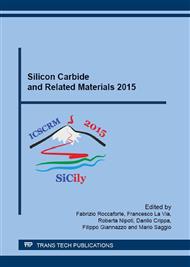p.777
p.782
p.786
p.790
p.797
p.803
p.807
p.812
p.817
Wide Band Gap Semiconductor Technology for Energy Efficiency
Abstract:
The attributes and benefits of wide-bandgap (WBG) semiconductors are rapidly becoming known, as their use in power electronics applications continues to gain industry acceptance. However, hurdles still exist in achieving widespread market acceptance, on a par with traditional silicon power devices. Primary challenges include reducing device costs and the expansion of a workforce trained in their use. The Department of Energy (DOE) is actively fostering development activities to expand application spaces, achieve acceptable cost reduction targets and grow the acceptance of WBG devices to realize DOEs core missions of more efficient energy generation, greenhouse gas reduction and energy security within the U.S. This paper discusses currently funded activities and application areas that are suitable for WBG introduction. A detailed cost roadmap for SiC device introduction is also presented.
Info:
Periodical:
Pages:
797-802
Citation:
Online since:
May 2016
Price:
Сopyright:
© 2016 Trans Tech Publications Ltd. All Rights Reserved
Share:
Citation:


